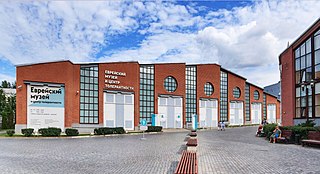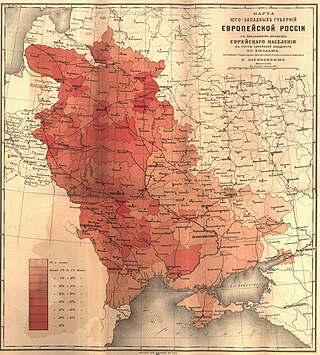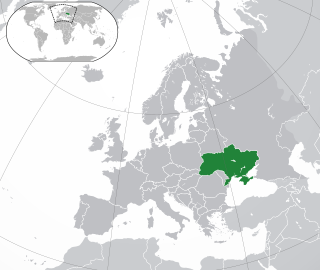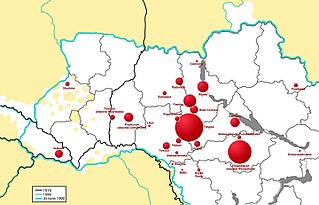
A pogrom is a violent riot incited with the aim of massacring or expelling an ethnic or religious group, particularly Jews. The term entered the English language from Russian to describe 19th- and 20th-century attacks on Jews in the Russian Empire. Retrospectively, similar attacks against Jews which occurred in other times and places also became known as pogroms. Sometimes the word is used to describe publicly sanctioned purgative attacks against non-Jewish groups. The characteristics of a pogrom vary widely, depending on the specific incident, at times leading to, or culminating in, massacres.

The history of the Jews in Russia and areas historically connected with it goes back at least 1,500 years. Jews in Russia have historically constituted a large religious and ethnic diaspora; the Russian Empire at one time hosted the largest population of Jews in the world. Within these territories, the primarily Ashkenazi Jewish communities of many different areas flourished and developed many of modern Judaism's most distinctive theological and cultural traditions, while also facing periods of antisemitic discriminatory policies and persecution, including violent pogroms.

The Pale of Settlement was a western region of the Russian Empire with varying borders that existed from 1791 to 1917 in which permanent residency by Jews was allowed and beyond which Jewish residency, permanent or temporary, was mostly forbidden. Most Jews were still excluded from residency in a number of cities within the Pale as well. A few Jews were allowed to live outside the area, including those with university education, the ennobled, members of the most affluent of the merchant guilds and particular artisans, some military personnel and some services associated with them, including their families, and sometimes their servants. Pale is an archaic term meaning an enclosed area.

The Kishinev pogrom or Kishinev massacre was an anti-Jewish riot that took place in Kishinev, then the capital of the Bessarabia Governorate in the Russian Empire, on 19–21 April [O.S. 6–8 April] 1903. During the pogrom, which began on Easter Day, 49 Jews were killed, 92 were gravely injured, a number of Jewish women were raped, over 500 were lightly injured and 1,500 homes were damaged. American Jews began large-scale organized financial help, and assisted in emigration. The incident focused worldwide attention on the persecution of Jews within the Russian Empire, and led Theodor Herzl to propose the Uganda Scheme as a temporary refuge for the Jews.

Cantonists were underage sons of conscripts in the Russian Empire. From 1721 on they were educated in special "cantonist schools" for future military service. The cantonist schools and the cantonist system were eventually abolished in 1857, following public and international criticism and the Russian defeat in the Crimean War.
A Jewish quota was a discriminatory racial quota designed to limit or deny access for Jews to various institutions. Such quotas were widespread in the 19th and 20th centuries in developed countries and frequently present in higher education, often at prestigious universities.
The history of the Jews in 19th-century Poland covers the period of Jewish-Polish history from the dismemberment of the Polish–Lithuanian Commonwealth, until the beginning of the 20th century.

The history of the Jews in Ukraine dates back over a thousand years; Jewish communities have existed in the modern territory of Ukraine from the time of the Kievan Rus'. Important Jewish religious and cultural movements, from Hasidism to Zionism, arose there. According to the World Jewish Congress, the Jewish community in Ukraine constitutes Europe's third-largest and the world's fifth-largest.
The First Aliyah, also known as the agriculture Aliyah, was a major wave of Jewish immigration (aliyah) to Ottoman Palestine between 1881 and 1903. Jews who migrated in this wave came mostly from Eastern Europe and from Yemen, stimulated by pogroms and violence against the Jewish communities in those areas. An estimated 25,000 Jews immigrated. Many of the European Jewish immigrants during the late 19th-early 20th century period gave up after a few months and went back to their country of origin, often suffering from hunger and disease.
Pogroms in the Russian Empire were large-scale, targeted, and repeated anti-Jewish rioting that began in the 19th century. Pogroms began to occur after Imperial Russia, which previously had very few Jews, acquired territories with large Jewish populations from the Polish–Lithuanian Commonwealth and the Ottoman Empire from 1772 to 1815. These territories were designated "the Pale of Settlement" by the Imperial Russian government, within which Jews were reluctantly permitted to live. The Pale of Settlement primarily included the territories of Poland, Ukraine, Belarus, Bessarabia, Lithuania and Crimea. Jews were forbidden from moving to other parts of European Russia, unless they converted from Judaism or obtained a university diploma or first guild merchant status. Migration to the Caucasus, Siberia, the Far East or Central Asia was not restricted.
Jewish disabilities were legal restrictions, limitations and obligations placed on European Jews in the Middle Ages. In Europe, the disabilities imposed on Jews included provisions requiring Jews to wear specific and identifying clothing such as the Jewish hat and the yellow badge, paying special taxes, swearing special oaths, living in certain neighbourhoods, and forbidding Jews to enter certain trades. In Sweden, for example, Jews were forbidden to sell new pieces of clothing. Disabilities also included special taxes levied on Jews, exclusion from public life, restraints on the performance of religious ceremonies, and linguistic censorship. Some countries went even further and outright expelled Jews, for example England in 1290 and Spain in 1492.

The Belostok (Białystok) pogrom occurred between 14–16 June 1906 in Białystok, Poland. During the pogrom, between 81 and 88 Jews were killed by soldiers of the Imperial Russian Army, the Black Hundreds, and about 80 people were wounded.
Anti-Jewish laws have been a common occurrence throughout Jewish history. Examples of such laws include special Jewish quotas, Jewish taxes and Jewish "disabilities".

Pogrom is derived from the Russian word погром. In Russia, the word pogrom was first used to describe the anti-Semitic attacks that followed the assassination of Tsar Alexander II in 1881. There was a second wave of pogroms in the early 20th century, between 1903 and 1906. Despite there being only two waves of pogroms, there had been a culture of anti-Semitism existing for centuries.
Antisemitism in the Russian Empire included numerous pogroms and the designation of the Pale of Settlement from which Jews were forbidden to migrate into the interior of Russia, unless they converted to the Russian Orthodox state religion.
Anti-Jewish boycotts are organized boycotts directed against Jewish people to exclude them economical, political or cultural life. Antisemitic boycotts are often regarded as a manifestation of popular antisemitism.

The Kiev pogrom of 1881 lasted for three days starting 26 April, 1881 in the city of Kiev and spread to villages in the surrounding region. Sporadic violence continued until winter. It is considered the worst of the pogroms that swept through south-western Imperial Russia in 1881. Pogroms continued on through the summer, spreading across the territory of modern-day Ukraine including Podolia Governorate, Volyn Governorate, Chernigov Governorate, Yekaterinoslav Governorate, and others.
The history of the Jews in Saint Petersburg dates back to the 18th century and there is still a Jewish community in the city today. In the late 18th century, the annexation of eastern Poland meant millions more Jews were now subjects of the Russian Empire, many of whom flocked to the city. When Catherine the Great created the Pale of Settlement to attempt to contain the new Jewish population, Jewish settlement was largely restricted. Under Tsar Alexander II upper class Jews fitting certain criteria were allowed to live in the city, and many other Jews who did not fit these categories settled illegally. By the end of his reign in 1881, the Jewish population of the city was 17,253. Unlike other cities in the Russian Empire, Saint Petersburg never had a pogrom, likely due to the amount of police and army presence it had as the capital. The community continued to grow, despite expulsions and persecution, and flourished creatively until the Bolshevik Revolution. Under the Soviet Union, Jewish life was stifled and repressed, and a number of Saint Petersburg Jews took part in the refusenik movement and underground revival of Jewish nationalism. Today, after the collapse of the Soviet Union, the city remains home to a sizable Jewish community and many Jewish institutions. The Grand Choral Synagogue of Saint Petersburg is the third-largest synagogue in Europe.
This timeline of antisemitism chronicles the acts of antisemitism, hostile actions or discrimination against Jews as a religious or ethnic group, in the 19th century. It includes events in the history of antisemitic thought, actions taken to combat or relieve the effects of antisemitism, and events that affected the prevalence of antisemitism in later years. The history of antisemitism can be traced from ancient times to the present day.

The pogroms during the Russian Civil War were a wave of mass murders of Jews, primarily in Ukraine, during the Russian Civil War. In the years 1918–1920, there were 1,500 pogroms in over 1,300 localities, in which up to 250,000 were murdered. All armed forces operating in Ukraine were involved in the killings, in particular the anti-Communist Ukrainian People's Army and Armed Forces of South Russia. It is estimated that more than a million people were affected by material losses, 50,000 to 300,000 children were orphaned, and half a million were driven out from or fled their homes.










